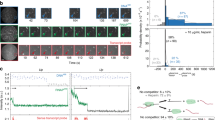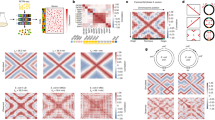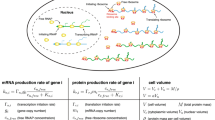Abstract
Gene expression, DNA replication and genome maintenance are all initiated by proteins that must recognize specific targets from among a vast excess of nonspecific DNA. For example, to initiate transcription, Escherichia coli RNA polymerase (RNAP) must locate promoter sequences, which compose <2% of the bacterial genome. This search problem remains one of the least understood aspects of gene expression, largely owing to the transient nature of search intermediates. Here we visualize RNAP in real time as it searches for promoters, and we develop a theoretical framework for analyzing target searches at the submicroscopic scale on the basis of single-molecule target-association rates. We demonstrate that, contrary to long-held assumptions, the promoter search is dominated by three-dimensional diffusion at both the microscopic and submicroscopic scales in vitro, which has direct implications for understanding how promoters are located within physiological settings.
This is a preview of subscription content, access via your institution
Access options
Subscribe to this journal
Receive 12 print issues and online access
$189.00 per year
only $15.75 per issue
Buy this article
- Purchase on Springer Link
- Instant access to full article PDF
Prices may be subject to local taxes which are calculated during checkout





Similar content being viewed by others
References
Haugen, S.P., Ross, W. & Gourse, R.L. Advances in bacterial promoter recognition and its control by factors that do not bind DNA. Nat. Rev. Microbiol. 6, 507–519 (2008).
Browning, D.F. & Busby, S.J. The regulation of bacterial transcription initiation. Nat. Rev. Microbiol. 2, 57–65 (2004).
Saecker, R.M., Record, M.T. & Dehaseth, P.L. Mechanism of bacterial transcription initiation: RNA polymerase—promoter binding, isomerization to initiation-competent open complexes, and initiation of RNA synthesis. J. Mol. Biol. 412, 754–771 (2011).
Nudler, E. RNA polymerase active center: the molecular engine of transcription. Annu. Rev. Biochem. 78, 335–361 (2009).
Mendoza-Vargas, A. et al. Genome-wide identification of transcription start sites, promoters and transcription factor binding sites in E. coli. PLoS ONE 4, e7526 (2009).
Cho, B.K. et al. The transcription unit architecture of the Escherichia coli genome. Nat. Biotechnol. 27, 1043–1049 (2009).
von Hippel, P.H. & Berg, O.G. Facilitated target location in biological systems. J. Biol. Chem. 264, 675–678 (1989).
Gorman, J. & Greene, E.C. Visualizing one-dimensional diffusion of proteins along DNA. Nat. Struct. Mol. Biol. 15, 768–774 (2008).
Berg, O.G. & Blomberg, C. Association kinetics with coupled diffusional flows. Special application to the lac repressor–operator system. Biophys. Chem. 4, 367–381 (1976).
Mirny, L. et al. How a protein searches for its site on DNA: the mechanism of facilitated diffusion. J. Phys. A 42, 434013 (2009).
Halford, S.E. & Marko, J.F. How do site-specific DNA-binding proteins find their targets? Nucleic Acids Res. 32, 3040–3052 (2004).
Berg, O.G., Winter, R.B. & von Hippel, P.H. Diffusion-driven mechanisms of protein translocation on nucleic acids. 1. Models and theory. Biochemistry 20, 6929–6948 (1981).
Riggs, A.D., Bourgeois, S. & Cohn, M. The lac repressor-operator interaction. 3. Kinetic studies. J. Mol. Biol. 53, 401–417 (1970).
Halford, S.E. An end to 40 years of mistakes in DNA-protein association kinetics? Biochem. Soc. Trans. 37, 343–348 (2009).
Li, G.-W., Berg, O.G. & Elf, J. Effects of macromolecular crowding and DNA looping on gene regulation kinetics. Nat. Phys. 5, 294–297 (2009).
Hu, T., Grosberg, A.Y. & Shklovskii, B.I. How proteins search for their specific sites on DNA: the role of DNA conformation. Biophys. J. 90, 2731–2744 (2006).
Bauer, M. & Metzler, R. Generalized faciliated diffusion model for DNA-binding proteins with search and recognition states. Biophys. J. 102, 2321–2330 (2012).
Kolesov, G., Wunderlich, Z., Laikova, O.N., Gelfand, M.S. & Mirny, L.A. How gene order is influenced by the biophysics of transcription regulation. Proc. Natl. Acad. Sci. USA 104, 13948–13953 (2007).
Wunderlich, Z. & Mirny, L.A. Spatial effects on the speed and reliability of protein-DNA search. Nucleic Acids Res. 36, 3570–3578 (2008).
Das, R.K. & Kolomeisky, A.B. Facilitated search of proteins on DNA: correlations are important. Phys. Chem. Chem. Phys. 12, 2999–3004 (2010).
Singer, P. & Wu, C.W. Promoter search by Escherichia coli RNA polymerase on a circular DNA template. J. Biol. Chem. 262, 14178–14189 (1987).
Ricchetti, M., Metzger, W. & Heumann, H. One-dimensional diffusion of Escherichia coli DNA-dependent RNA polymerase: a mechanism to facilitate promoter location. Proc. Natl. Acad. Sci. USA 85, 4610–4614 (1988).
Kabata, H. et al. Visualization of single molecules of RNA polymerase sliding along DNA. Science 262, 1561–1563 (1993).
Guthold, M. et al. Direct observation of one-dimensional diffusion and transcription by Escherichia coli RNA polymerase. Biophys. J. 77, 2284–2294 (1999).
Harada, Y. et al. Single-molecule imaging of RNA polymerase-DNA interactions in real time. Biophys. J. 76, 709–715 (1999).
Berg, J., Tymoczko, J. & Stryer, L. Biochemistry (W.H. Freeman, 2007).
Roe, J.H., Burgess, R.R. & Record, M.T. Jr. Kinetics and mechanism of the interaction of Escherichia coli RNA polymerase with the lambda PR promoter. J. Mol. Biol. 176, 495–522 (1984).
Friedman, L.J. & Gelles, J. Mechanism of transcription initiation at an activator-dependent promoter defined by single-molecule observation. Cell 148, 679–689 (2012).
deHaseth, P.L., Zupancic, M. & Record, M.T. Jr. RNA polymerase-promoter interactions: the comings and goings of RNA polymerase. J. Bacteriol. 180, 3019–3025 (1998).
Herbert, K.M., Greenleaf, W.J. & Block, S.M. Single-molecule studies of RNA polymerase: motoring along. Annu. Rev. Biochem. 77, 149–176 (2008).
Gorman, J., Fazio, T., Wang, F., Wind, S. & Greene, E.C. Nanofabricated racks of aligned and anchored DNA substrates for single-molecule imaging. Langmuir 26, 1372–1379 (2010).
Gorman, J., Plys, A.J., Visnapuu, M.L., Alani, E. & Greene, E.C. Visualizing one-dimensional diffusion of eukaryotic DNA repair factors along a chromatin lattice. Nat. Struct. Mol. Biol. 17, 932–938 (2010).
Gorman, J. et al. Single-molecule imaging reveals target search mechanisms during mismatch repair. Proc. Natl. Acad. Sci. USA 109, E3074–E3083 (2012).
Finkelstein, I.J., Visnapuu, M.L. & Greene, E.C. Single-molecule imaging reveals mechanisms of protein disruption by a DNA translocase. Nature 468, 983–987 (2010).
Simons, R.W., Hoopes, B.C., McClure, W.R. & Kleckner, N. Three promoters near the termini of IS10: pIN, pOUT, and pIII. Cell 34, 673–682 (1983).
McClure, W.R. Rate-limiting steps in RNA chain initiation. Proc. Natl. Acad. Sci. USA 77, 5634–5638 (1980).
Hawley, D.K. & McClure, W.R. In vitro comparison of initiation properties of bacteriophage lambda wild-type PR and x3 mutant promoters. Proc. Natl. Acad. Sci. USA 77, 6381–6385 (1980).
Dayton, C.J., Prosen, D.E., Parker, K.L. & Cech, C.L. Kinetic measurements of Escherichia coli RNA polymerase association with bacteriophage T7 early promoters. J. Biol. Chem. 259, 1616–1621 (1984).
Brunner, M. & Bujard, H. Promoter recognition and promoter strength in the Escherichia coli system. EMBO J. 6, 3139–3144 (1987).
Wang, Y.M., Austin, R.H. & Cox, E.C. Single molecule measurements of repressor protein 1D diffusion on DNA. Phys. Rev. Lett. 97, 048302 (2006).
Elf, J., Li, G.W. & Xie, X.S. Probing transcription factor dynamics at the single-molecule level in a living cell. Science 316, 1191–1194 (2007).
Kim, J.H. & Larson, R.G. Single-molecule analysis of 1D diffusion and transcription elongation of T7 RNA polymerase along individual stretched DNA molecules. Nucleic Acids Res. 35, 3848–3858 (2007).
Tafvizi, A., Huang, F., Fersht, A.R., Mirny, L.A. & van Oijen, A.M. A single-molecule characterization of p53 search on DNA. Proc. Natl. Acad. Sci. USA 108, 563–568 (2011).
Berg, O.G. Orientation constraints in diffusion-limited macromolecular association. The role of surface diffusion as a rate-enhancing mechanism. Biophys. J. 47, 1–14 (1985).
Austin, R.H., Karohl, J. & Jovin, T.M. Rotational diffusion of Escherichia coli RNA polymerase free and bound to deoxyribonucleic acid in nonspecific complexes. Biochemistry 22, 3082–3090 (1983).
Gorman, J. et al. Dynamic basis for one-dimensional DNA scanning by the mismatch repair complex Msh2-Msh6. Mol. Cell 28, 359–370 (2007).
Berg, O.G. & von Hippel, P.H. Diffusion-controlled macromolecular interactions. Annu. Rev. Biophys. Biophys. Chem. 14, 131–160 (1985).
Moran, U., Philips, R. & Milo, R. Snapshot: key numbers in biology. Cell 141, 1262–1262.e1 (2010).
Minton, A.P. The influence of macromolecular crowding and macromolecular confinement on biochemical reactions in physiological media. J. Biol. Chem. 276, 10577–10580 (2001).
Graham, J.S., Johnson, R.C. & Marko, J.F. Concentration-dependent exchange accelerates turnover of proteins bound to double-stranded DNA. Nucleic Acids Res. 39, 2249–2259 (2011).
Ishihama, A. Functional modulation of Escherichia coli RNA polymerase. Annu. Rev. Microbiol. 54, 499–518 (2000).
Hammar, P. et al. The lac repressor displays faciliated diffusion in living cells. Science 336, 1595–1598 (2012).
McClure, W.R. Mechanism and control of transcription initiation in prokaryotes. Annu. Rev. Biochem. 54, 171–204 (1985).
So, L.H. et al. General properties of transcriptional time series in Escherichia coli. Nat. Genet. 43, 554–560 (2011).
Reppas, N.B., Wade, J.T., Church, G.M. & Struhl, K. The transition between trancriptional initiation and elongation in E. coli is highly variable and often rate limiting. Mol. Cell 24, 747–757 (2006).
Shaevitz, J.W., Abbondanzieri, E.A., Landick, R. & Block, S.M. Backtracking by single RNA polymerase molecules observed at near-base-pair resolution. Nature 426, 684–687 (2003).
Acknowledgements
We thank M. Gottesman, R. Gonzalez and the Greene laboratory for assistance and discussion throughout this work. We thank M. Gottesman, D. Duzdevich and members of our laboratories for carefully reading the manuscript. We thank R. Landick (University of Wisconsin–Madison, Madison, Wisconsin, USA) for providing RNAP expression constructs. This work was supported by US National Institutes of Health grants GM074739 (E.C.G.) and F32GM80864 (I.J.F.) and training grant T32GM00879807 (J.G.), a US National Science Foundation Award (E.C.G.) and by the Howard Hughes Medical Institute.
Author information
Authors and Affiliations
Contributions
F.W. collected the RNAP experimental data, and F.W. and S.R. analyzed the data. S.R. developed the theoretical analysis, conducted theoretical calculations, assisted with the RNAP data collection and collected the data for the lac repressor. D.R.R. assisted with development of the theory. I.J.F. assisted in establishing the single-molecule assays for QD-RNAP and QD-lac repressor. J.G. developed the substrate for the DIG-QD measurements and collected the corresponding data. E.C.G. supervised the project, and all authors co-wrote the paper.
Corresponding author
Ethics declarations
Competing interests
The authors declare no competing financial interests.
Supplementary information
Supplementary Text and Figures
Supplementary Figures 1–11, Supplementary Tables 1–4 and Supplementary Note (PDF 1500 kb)
Rights and permissions
About this article
Cite this article
Wang, F., Redding, S., Finkelstein, I. et al. The promoter-search mechanism of Escherichia coli RNA polymerase is dominated by three-dimensional diffusion. Nat Struct Mol Biol 20, 174–181 (2013). https://doi.org/10.1038/nsmb.2472
Received:
Accepted:
Published:
Issue Date:
DOI: https://doi.org/10.1038/nsmb.2472
This article is cited by
-
A mini-review of the diffusion dynamics of DNA-binding proteins: experiments and models
Journal of the Korean Physical Society (2021)
-
Alternative transcription cycle for bacterial RNA polymerase
Nature Communications (2020)
-
Transcription reinitiation by recycling RNA polymerase that diffuses on DNA after releasing terminated RNA
Nature Communications (2020)
-
A Canonical Biophysical Model of the CsrA Global Regulator Suggests Flexible Regulator-Target Interactions
Scientific Reports (2018)
-
Direct observation of TALE protein dynamics reveals a two-state search mechanism
Nature Communications (2015)



